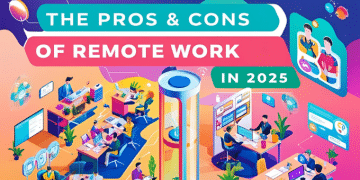Your Guide On How To Land A High-Paying Remote Job In 2025

The way Americans work has changed by a lot. By 2025, over 36 million people in the U.S. will work from home, as stated by Upwork. But while remote opportunities are growing, so is the competition. With the rising number of job seekers, businesses are getting pickier than ever. Now, they’re looking for those who show not just the skills, but also the will and talk needed to do well outside a classic office.
This guide helps you find your way in the changing work-from-home job world with ease. Whether you’re looking to transition from an office job, find a better remote position, or start freelancing, you’ll learn:
- The most in-demand remote jobs and skills for 2025
- Where to find high-paying remote opportunities (beyond LinkedIn)
- How to tailor your resume and LinkedIn profile for remote roles
- Red flags to watch for in remote job USA postings
- Salary negotiation strategies for remote positions
Let’s dive in.
Why Remote Work Is the Future (and How to Position Yourself for Success)

Remote work is not just a fad—it’s changing how companies run. Here’s why:
- Money saved for firms: Bosses save $11,000 a year per remote worker on office space (Global Workplace Analytics).
- Increased productivity: A 2024 Stanford study showed remote workers do 9% more than their in-office peers.
- Worker demand: 74% of U.S. professionals say they would consider leaving their current job for a fully remote role (Buffer).
The key takeaway? The work from home setup is here to stay, but that also means that the competition will only get fiercer from here on out.
Read next: How To Write The Perfect Cover Letter In 2025: A Complete Guide!
Step 1: Identify the Best Remote Jobs for Your Skills
Not all remote jobs are created equal. Some industries and roles are more remote-friendly than others. Here’s what’s in demand for 2025:
Highest-Paying Remote Jobs in 2025
- Software Engineers & Developers (120K–120K–200K)
- Specializations: AI, cloud computing, cybersecurity
- Digital Marketing Managers (90K–90K–150K)
- Skills: SEO, paid ads, data analytics
- UX/UI Designers (85K–140K)
- Tools: Figma, Sketch, user testing
- Freelance Writers & Content Strategists (60K–120K)
- Freelance opportunities niches: B2B tech, healthcare, finance
Emerging Remote Roles to Watch
- AI Prompt Engineers (Companies paying $150+/hour for ChatGPT optimization)
- Remote Compliance Officers (Healthcare and finance sectors)
- Virtual Executive Assistants (For startups and entrepreneurs)
Action Step: Look up job ads in your field to find which remote jobs fit your skills.
Step 2: Develop the Skills Employers Want
Remote work needs special skills, not just tech know-how. Here’s what bosses want:
Technical Skills (Industry-Specific)
- For Tech Roles: AWS, Python, cybersecurity certifications
- For Marketing: Google Analytics, HubSpot, SEO tools
- For Project Management: Asana, Trello, Scrum/Agile
Soft Skills (Critical for Remote Success)
- Written Communication (Clear, concise emails and Slack messages)
- Time Management (Pomodoro technique, time-blocking)
- Problem-Solving (Ability to troubleshoot tech issues independently)
Pro Tip: Take free courses on Coursera or LinkedIn Learning to fill skill gaps.
Step 3: Find Hidden Remote Job Opportunities
Most remote job seekers rely on LinkedIn, but the best opportunities are often found elsewhere.
Best Job Boards for Remote Work
- We Work Remotely (Tech, marketing, and design roles)
- Remote.co (Curated remote jobs from reputable companies)
- FlexJobs (Scam-free listings, worth the $7/month fee)
Alternative Strategies
- Twitter Search: Try “hiring remote [your job title]” for unposted roles.
- AngelList: Great for startup remote jobs.
- Cold Emailing: Use Hunter.io to find hiring managers.
Avoid Scams: Never pay to apply for a job. Legit companies will interview over Zoom, not Telegram.
Step 4: Optimize Your Resume and LinkedIn for Remote Jobs
Your resume needs to scream “I’m built for remote work.” Here’s how to showcase remote work tips in your application.
Resume Tips
- Add a “Remote Work Skills” section (e.g., “Slack, Trello, Async Communication”).
- Highlight measurable results (e.g., “Increased remote team productivity by 30%”).
- Use an ATS-friendly template (Try Kickresume or Canva).
LinkedIn Optimization
- Headline: “Remote [Your Role] | AI & Cloud Specialist”
- About Section: Mention your work from home experience and #OpenToRemoteWork.
- Posts: Share insights on remote productivity to attract recruiters.
Bonus: Record a 1-minute Loom video introducing yourself and link it in applications.
Step 5: Ace the Remote Job Interview
Remote interviews test different skills than in-person ones. Be ready for:
Common Questions
- “How do you stay productive at home?”
- Answer: “I use time-blocking and tools like Focus@Will to minimize distractions.”
- “Describe a time you solved a problem remotely.”
- Use the STAR method (Situation, Task, Action, Result).
Practical Tests
- Take-home assignments (Submit early and document your process).
- Live collaboration (Google Docs, Figma, or coding challenges).
Red Flag: If they won’t do a video call, it’s likely a scam.
Read next: How to Negotiate Your Salary in 7 Strategic Steps: Get The Salary You Deserve
Step 6: Negotiate Your Remote Job Offer Like a Pro
How to negotiate digital nomad benefits:
Salary Ranges for Remote Roles
- Entry-level: 50K–80K
- Mid-career: 90K–130K
- Senior roles: $150K+ (Especially in AI and cybersecurity)
What to Ask For
- Home office stipend (500–1,000/year)
- Flexible hours (Core hours vs. fully async)
- Co-working space membership (WeWork, Spaces)
Negotiation Tip: Use salary data from Glassdoor or Levels.fyi to justify your ask.
Step 7: Avoid Common Remote Work Pitfalls
Red flags in digital nomad job postings are more often than you think. Here’s how to handle them:
Isolation & Burnout
- Fix: Join remote work communities (like Remote Work Association).
- Schedule regular coworking days (Even virtual ones on Zoom).
Time Zone Challenges
- Fix: Set clear availability hours in your Slack status.
- Use tools like World Time Buddy to schedule meetings.
Career Growth Concerns
- Fix: Request quarterly performance reviews.
- Seek out remote-friendly mentors.
Step 8: Build a Long-Term Remote Career
Remote work is more than getting a job—it’s keeping a good career.
Ways to Stay Competitive
- Upskill annually (Take new certifications in your field).
- Build a personal brand (Write on LinkedIn or start a niche blog).
- Network virtually (Attend remote work webinars and events).
When to Consider Freelancing
If you value location independence and multiple income streams, freelancing might be your next step. Platforms like Upwork and Toptal can help you get started.
How to Build a Standout Remote Work Portfolio (Even With No Experience)
Landing a remote job often requires proving you can deliver results independently. Here’s how to create a portfolio that gets hiring managers excited:
Portfolio Essentials for Remote Roles
- Showcase tangible results:
- Before/after screenshots of projects you’ve improved
- Case studies with metrics (e.g., “Increased email open rates by 37%”)
- Demonstrate remote-ready skills:
- Samples of async communication (well-documented project briefs)
- Video walkthroughs explaining your work process
Creative Solutions for Beginners
- Volunteer work: Offer skills to nonprofits (Great for building first case studies)
- Passion projects: Build a mock campaign for a fictional company
- Micro-freelancing: Complete 5-10 small jobs on Upwork to gather testimonials
Read next: How to Find High-Paying Jobs in the USA: 2025 Career Hacks That Work
The Future of Remote Work: What to Expect In The Coming Years

How to stay ahead in freelance opportunities:
Coming Soon to Remote Jobs
- AI co-workers: ChatGPT-like assistants for daily tasks
- 4-day workweeks: 61% of work from home companies testing this (2025 Pilot Program)
- Virtual reality offices: Meta’s Horizon Workrooms gaining traction
How to Future-Proof Your Career
Skills to learn now:
- AI collaboration tools
- Cross-cultural remote teamwork
- Data privacy management
- Industries going fully remote:
- Healthcare admin (27% growth)
- Online education (Khan Academy model)
Your Remote Work Action Plan
The remote job market is moving fast, but with the right strategy, you can land a high-paying remote role in 2025. Start by identifying jobs that match your skills, then sharpen both your technical and soft skills.
Don’t just rely on LinkedIn; explore niche job boards and X (formerly Twitter) for hidden opportunities. Optimize your resume and LinkedIn for remote roles, prep for remote-specific interviews, and negotiate with confidence. Avoid common pitfalls and stay focused on long-term growth.
Ready to take the next step? Start applying today—your dream remote job is out there!





